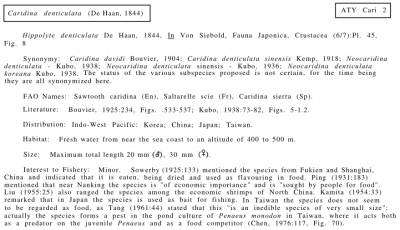Neocaridina heterporoda (syn. Neocaridina denticulata, Neocaridina sinensis) теперь называется Neocaridina davidi, Bouvier, 1904.
Надолго ли...
Т.к. Werner Klotz и Andreas Karge нашли данное название в неких «ранних» научных работах, то решили, что следовательно, это название и является первым и правильным научным названием этого вида креветок, о чём они и написали в 3-ем издании своей книги Süßwassergarnelen aus aller Welt (ISBN 978-3935175-90-6).
Учитывая, что раньше эти же креветки ...аж ещё в 1844 году были названы де Хааном... Caridina denticulata (De Haan, 1844), то логично ожидать очередного переименовывания в Neocaridina denticulata...
...и вот как это выглядело в одной давней научной работе на странице 72 (источник):
  "> ">
Caridina denticulata (De Haan, 1844) ATY Cari 2
Hippolyte denticulata De Haan, 1844, In Von Siebold, Fauna Japonica, Crustacea (6/7):Pl. 45, Fig. 8 Synonymy: Caridina davidi Bouvier, 1904; Caridina denticulata sinensis Kemp, 1918; Neocaridina denticulata - Kubo, 1938; Neocaridina denticulata sinensis - Kubo, 1936; Neocaridina denticulata koreana Kubo, 1938. The status of the various subspecies proposed is not certain, for the time being they are all synonymized here. FAO Names: Sawtooth caridina (En), Saltarelle scie (Fr), Caridina sierra (Sp). Literature: Bouvier, 1925:234, Figs. .533-537; Kubo, 1938:73-82, Figs. 5-1.2. Distribution: Indo-West Pacific: Korea; China; Japan; Taiwan. Habitat: Fresh water from near the sea coast to an altitude of 400 to 500 m. Size: Maximum total length 20 mm , 30 mm . Interest to Fishery: Minor. Sowerby (1925:133) mentioned the species from Fukien and Shanghai, China and indicated that it is eaten, being dried and used as flavouring in food. Ping (1931:183)
mentioned that near Nanking the species is "of economic importance" and is "sought by people for food".
Liu (1955:25) also ranged the species among the economic shrimps of North China. Kamita (1954:33)
remarked that in Japan the species is used as bait for fishing. In Taiwan the species does not seem
to be regarded as food, as Tang (1961:44) stated that this "is an inedible species of very small size";
actually the species forms a pest in the pond culture of Penaeus monodon in Taiwan, where it acts both
as a predator on the juvenile Penaeus and as a food competitor (Chen, 1976:117, Fig. 70).
Напомню, что название Neocaridina heteropoda (Liang, 2002) было присвоено данному виду креветок в результате очередной ревизии рода и вида специалистом в систематике креветок...
|







